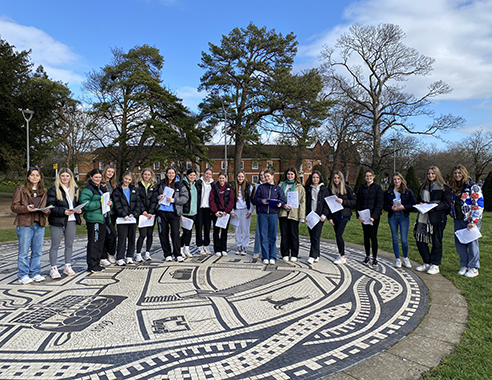
By Mrs McPhail (Geography Teacher)
The A level Geographers have taken to the streets of Bedford for fieldwork on two separate occasions in the last few days, such is the large cohort of Geographers.
As part of the Geography A Level specification, the students have to make a study of a local place. It is great to be able to maximise our use of time and step out of the gates and start fieldwork in Bedford straight away. In May, we will take the Lower Sixth IB and A Level Geographers further afield to Dorset and investigate the contrasting seaside resort of Boscombe.
We walked a set route through Bedford from the school site to Queen’s Park and back, this allows the students to look at changes that are taking place and to observe at first hand the different areas of the town. This year, we were on the lookout for Ghost signs in Lime Street and surveyed the increasing variety of restaurants giving an insight into cultural change. Whilst the High Street does have the odd empty shop there are signs of new initiatives doing their best to attract investment back into the town centre with many historical buildings being given a facelift.
At 12 different sites, the students observed people and peoples use of space, completed Environmental Quality surveys and used a GIS app on their phones to complete a pre-planned survey. Capturing data in ‘real time’ is fantastic and allows Geographers to analyse and present data using complex skills. The information gathered provides key material for the Changing Places unit in the Human Geography paper and is vital preparation for the NEAs (Non – Examined Assessment – coursework) that the students will complete independently The fieldwork route ended at the Higgins Museum which holds a permanent exhibit called Somewhere in England, where the students looked at the history behind Bedford’s growth as an important town..
Sophia Osborne (Lower Sixth) said: “The trip was a great opportunity to explore the different areas of Bedford and develop my perception of the place. By visiting 12 sites in Bedford and completing the ‘Place Diagram’ and the ‘Non-Participant Observation’ charts, it helped expand my understanding of the local area, which I will be able to use as a case study example.”
Remember to follow the Geography department updates @BGS_Geography here.





















